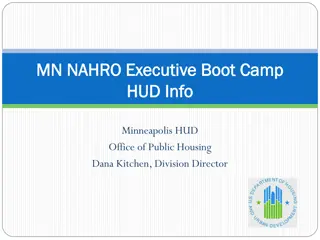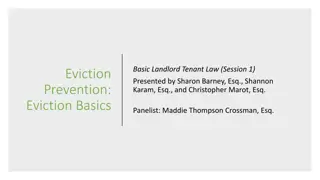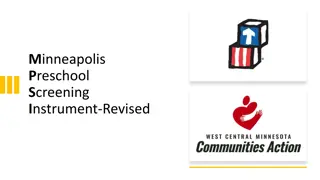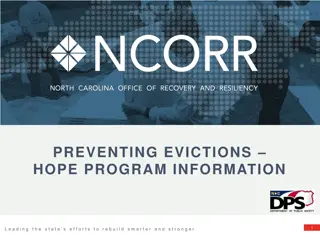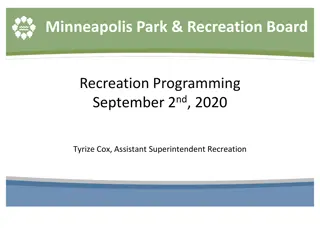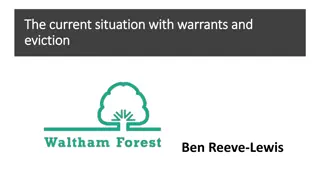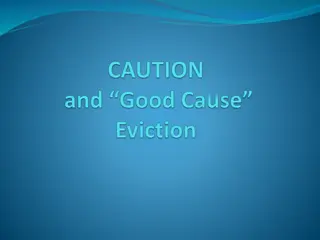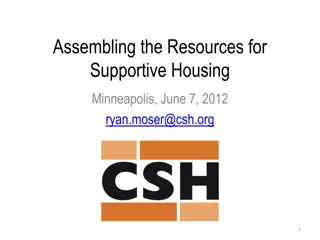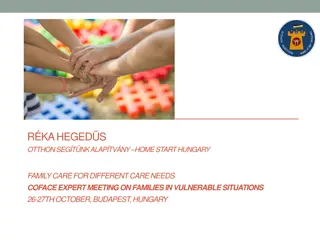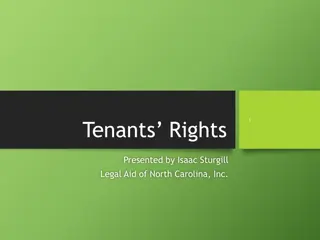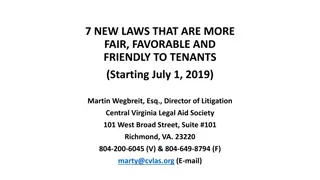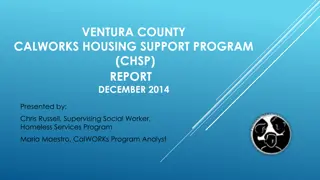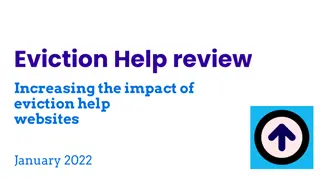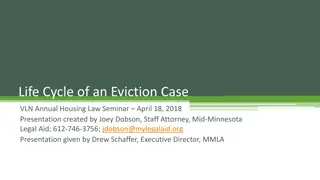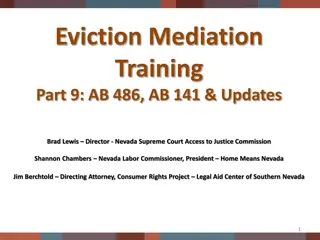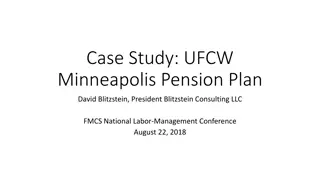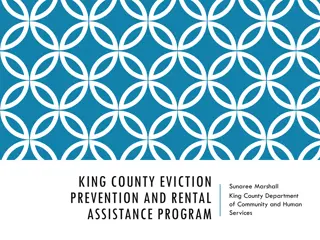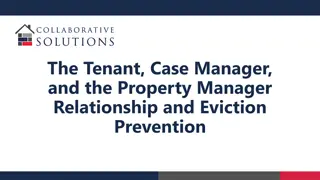Supporting Families Facing Eviction in Minneapolis
In Minneapolis, there are around 3,000 tenant evictions filed annually, disproportionately affecting low-income and minority neighborhoods. The evictions are mainly due to non-payment of rent, with tenants owing an average of $1,700 to $2,000. Various initiatives like the Habitation Rights Project and Eviction Representation Project provide legal support to tenants, resulting in positive outcomes and reduced eviction rates.
Download Presentation

Please find below an Image/Link to download the presentation.
The content on the website is provided AS IS for your information and personal use only. It may not be sold, licensed, or shared on other websites without obtaining consent from the author. Download presentation by click this link. If you encounter any issues during the download, it is possible that the publisher has removed the file from their server.
E N D
Presentation Transcript
Supporting families who have been evicted or are at-risk of eviction in the City of Minneapolis Brittany Lewis, PhD Research Associate Center for Urban and Regional Affairs University of Minnesota
In Minneapolis, there are about 3,000 tenant evictions filed annually, which represents a citywide rate of about 3.5%. This figure reflects only those cases officially filed in housing court, a equal or greater number of households likely experience an informal eviction each year. Evictions disproportionately impact people living in low income and minority neighborhoods; over 3 years, it is estimated that nearly half of renter households in North Minneapolis experienced an eviction filing. Collecting Data on evictions in the City of Minneapolis Non-Payment of rent accounts for over 90% of eviction filings; typically tenants owe $1,700 (median) to $2,000 (average), or about 1 to 3 months rent Research Conducted by the Minneapolis Research Conducted by the Minneapolis Innovation Team Innovation Team In 2015, just 10 property owners filed over 25% of evictions in Minneapolis; these property owners include both public housing as well as owners with a history of frequent housing code violations. Half of all cases result in an eviction judgement; and two-thirds of cases result in tenant displacement6 1 out of 3 tenants do not show up for the first hearing Though most cases initially settle, 40% of settlements fail FIND FULL REPORT HERE: http://innovateminneapolis.com/reducing-evictions/
McKnight Foundation-funded Habitability Rights Project enable lawyers and tenant organizers to gather groups of tenants and on their behalf, file affirmative actions known as rent escrow and tenant remedies against landlords that refuse to make repairs. Legal Aid and the Volunteer Lawyers Network work together to staff the Housing Court Project, which make at least two lawyers available on the same floor of the courthouse where evictions and rent escrow hearings and trials take place. They will draft court pleadings and give advice to tenants to help them prepare for their hearings. The work often focuses on tenants who have hearings on the same day they arrive to meet with the lawyers. Not including the Volunteer Lawyers Network, Legal Aid attorneys helped 437 tenants with motions to expunge previous eviction files from their records in 2016. Piloting Legal Support Programs The Eviction Representation Project provides same-day, in-court representation to the most vulnerable tenants who arrive for eviction hearings. Lawyers in this project represent tenants identified by the lawyers staffing the Housing Court Project, help them negotiate with their landlords and appear on their behalf before the Court. Once representing, the attorney will continue representation throughout the case and through trial. The Project existed for just six months of 2016. The work yielded 302 families represented and a 0% eviction rate. Mid-Minnesota Legal Aid Housing Division Luke Grundman
Of those clients represented only by Legal Aid (2,335) 74% identified as of a race or ethnicity other than non-Hispanic white. More than half (52%) identified as African American. 68% of represented families had women as their heads-of- household. More than 80% of represented families had income below the federal poverty guidelines, and more than 97% had income of less than twice the poverty guidelines. 55% consisted of families with at least one child. Outcomes of Pilot Legal Support Programs Represented clients achieved a positive outcome in 96% of cases, including 566 full-representation cases in which housing was verifiably protected for the long-term. Mid-Minnesota Legal Aid Housing Division Luke Grundman 52 cases protected tenants from discrimination. 228 cases involved full-scale representation in eviction trials or other contested court proceedings. Attorneys spent a median 21.6 hours per case preparing for eviction trials, a figure that does not include non-attorney staff time spent on a case (paralegals, interpreters, etc.).
Legal Aid avoided eviction and obtained better housing for a large family. Two women with a combined total of 10 kids faced an eviction due to alleged failure to pay rent. In fact, their money had gone to a series of medical bills and attendant costs that stemmed from lead poisoning in their home. Legal Aid lawyers represented the clients in court. They helped them assert defenses that stemmed from the landlord s failure to maintain the property in a habitable condition. After two days of trial, the judge agreed with the Legal Aid lawyers and their clients. The judge refused to grant the landlord an eviction, reduced the client s rent obligation to $0, and ordered the landlord to make the repairs before he could collect rent again. The landlord immediately paid for all the costs necessary to abate the lead paint hazards and made the property habitable again for the clients. Narrative Report from the Courts
Multiple community and government entities in Minneapolis and Hennepin County have engaged in conversation about how to reduce the number of evictions. The strategies they have identified include the following: Developing early interventions to get rent paid on time, Enforcing housing codes, Post-Evictions Data Report Reducing eviction as a first response to unpaid rent, Improving outcomes for tenants following an eviction, and Strategic Plans of Action Hennepin County Office to End Homelessness Lisa Thornquist Developing policy solutions. Preliminary research conducted by the staff of the Office of Housing Stability at Hennepin County has documented the current use of Emergency Assistance and Emergency General Assistance (EA and EGA, respectively). Hennepin County Staff have begun strategic conversations with advocates and will conduct focus groups with renters in North Minneapolis over the summer of 2017, because it is the portion of the city with the highest concentration of evictions. Hennepin County Staff is also conducting an intercept survey of tenants leaving Housing Court to capture demographics and understand the outcome of the court proceedings.
A Qualitative Approach to Inquiry The Center for Urban and Regional Affairs (CURA) will begin to collect qualitative data in the fall of 2017, to further inform the creation of specific City and County policies and practices based on the experiential knowledge shared by the tenants and landlords most affected by evictions in Minneapolis: Conduct 50 interviews with tenants who have experienced evictions and live in the two zip codes (55411 & 55412) with the largest concentration of evictions in 2015, to identify the issues leading up to housing instability, understand history of tenants housing composition overtime, and determine what economic resources tenants rely on or need. Conduct 20 interviews with landlords serving residents in the two zip codes where evictions are most prominent in the city to learn about their individual policies surrounding evictions, understand how they determine the cost benefit of evictions and rental ownership in general, and gain a detailed analysis of what steps are taken after an eviction determination is rendered. ] Post-Evictions Data Report Strategic Plans of Action The Center for Urban and Regional Affairs (CURA) Brittany Lewis, PhD


